 Edit article
Edit articleSeries
We Were Slaves to the Hyksos in Egypt

Second stele of the Theban Egyptian ruler Kamose (detail), 16th c. B.C.E., relating his campaign against the Hyksos, now in the Luxor Museum. R. Stehn/Wikimedia/CC BY-SA 2.0
The biblical exodus account describes a mass refugee movement in which thousands of Hebrews (or Israelites) fled Egypt following the downfall of an unnamed Egyptian Pharaoh.[1] Trouble begins when Pharaoh enslaves and abuses his Hebrew subjects, thereby incurring the wrath of their god. In return, God sends Moses to strike Egypt with a host of natural disasters, including the plagues of hail, darkness, and the death of the Egyptian firstborn. The Israelites flee Egypt, but Pharaoh and the Egyptian army follow, only to be destroyed at the Reed Sea. The Israelites continue into the wilderness, where they find themselves critically short of food and water, surviving only through the grace of God. A generation later, some of their descendants finally reach safety in Canaan.
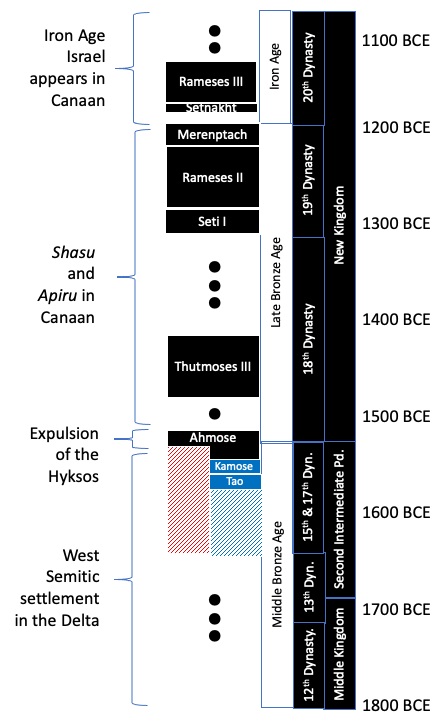
Figure 1. Timeline
Scholars interested in finding a historical basis for the story—some believe any such approach to be futile[2]—generally work backwards from the archaeological evidence in Canaan (Timeline, Figure 1).[3] Since mass settlement of the Judean and Samarian highlands took place in the 12th century B.C.E., they assume that the exodus from Egypt must have taken place shortly before. The most commonly suggested time is during the reign of the 19th dynasty ruler Ramesses II (ca. 1279–1213 B.C.E.)[4] or his son Merneptah (ca. 1213–1203),[5] though recently the reigns of the 20th dynasty ruler Sethnakht (ca. 1198–1194 B.C.E.) or his son Ramesses III (ca. 1194–1184 B.C.E.) have also been floated.[6] They then struggle to find some event during this period upon which the exodus and plague accounts could have been based, or to explain away the lack of Egyptian evidence for such events.
If, however, one is willing to consider the possibility that the exodus may already have belonged to the distant past by the time these settlements appeared, one can easily identify an event that contains many overlaps with the exodus story: The expulsion of the foreign Hyksos 15th dynasty rulers of the Delta by the native Egyptian 17th dynasty rulers of Thebes at the end of the Second Intermediate Period, (ca. 1535 B.C.E.). The “Pharaohs” of the biblical enslavement and exodus were, I would submit, the 15th Dynasty Hyksos rulers of the Delta, and the Hebrew slaves of the biblical account were their lower-class West Semitic subjects.
Native Egyptian Overthrow of the Hyksos 15th Dynasty
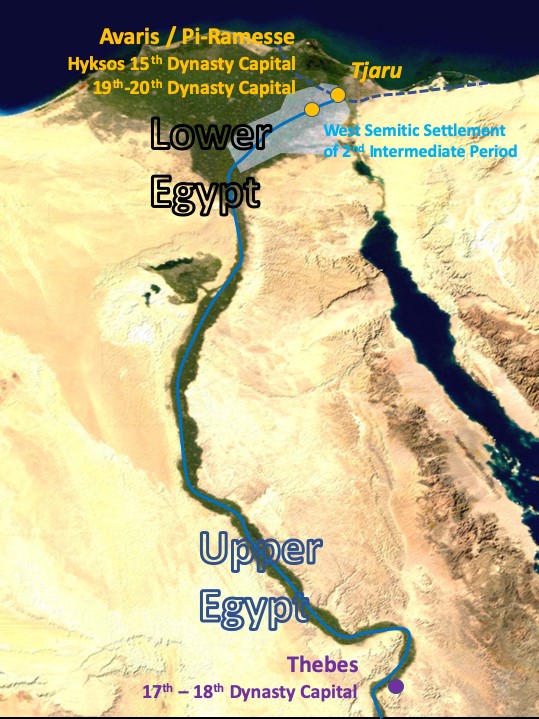
During the Second Intermediate period (ca. 1683–1535 B.C.E.), Egypt was politically and culturally divided.[7] Much of the population of the Nile Delta was West Semitic (the broader ethnic category to which biblical Israel belonged), while Upper Egypt was native Egyptian. The foreign Hyksos 15th dynasty ruled the Delta and much of Lower Egypt from its capital at Avaris in the north, while the native Egyptian 17th dynasty ruled Upper Egypt from its capital at Thebes in the south (Map, Figure 2). Surviving records and monuments from this period are sparse and often uninformative, so we are largely dependent upon archaeology and occasional records from the south for its history.[8]
Towards the end of the Second Intermediate Period, the native Egyptian rulers of Thebes began a concerted campaign to reunify Egypt under their own leadership. According to the Egyptian tale of “Apophis and Seqenenre,” the campaign against the Hyksos began when the Theban ruler Se-qenen-reꜥ Tao[9] (dates uncertain) went to war against the Hyksos ruler Apophis (dates uncertain), his northern neighbor.[10] Tao’s mummified body shows signs of a very violent death, suggesting that he died in this war or had been ritually executed following capture.[11] His son Wadj-kheper-reꜥ Kamose continued the fight, and boasted of the campaign on two victory stelae which he erected in the Karnak Temple (Stele, pictured above).[12] Kamose, however, died before completing the conquest.
Kamose’s younger brother Neb-peḥti-reꜥ Ahmose (ca. 1550–1525 B.C.E.) finally succeeded in conquering Avaris and expelling the Hyksos from Egypt, sometime around 1535 B.C.E. The conquest of the Hyksos capital of Avaris was noted briefly in a tomb inscription by one of Ahmose’s generals,[13] and was commemorated by wall reliefs in the king’s funerary temple at Abydos.[14] Once he succeeded in conquering the north, Ahmose founded the 18th dynasty, the first dynasty of the New Kingdom, which ruled once again over a united Egypt.
The defeat of the Hyksos triggered a mass flight of West Semites from the Delta. It also coincided with natural disasters, which the Egyptian sources blame upon a deity of the West Semites. Identification of the exodus with this event even has the support of ancient Egyptian tradition, as reported by the Hellenistic Egyptian priests and historians Manetho and Ptolemy of Mendes.
1. West Semites in the Delta
Starting in the late Middle Kingdom, and continuing on into the Second Intermediate Period, the population of the Egyptian Nile Delta was predominantly West Semitic.[15] We know this from extensive excavations in the area, including the 15th dynasty Hyksos capital of Avaris, located in the vicinity of modern Tell el-Dabʿa, along the former Pelusiac branch of the Nile.[16] Avaris figures prominently in the biblical account, where it is called by its later name of Rameses. Other major West Semitic population centers can be found all along this same branch, and in the Wadi Tumilat. Many of these sites have also now been excavated or at least surveyed. Some of these can also be correlated with places mentioned in the biblical account.[17]
This large, intrusive West Semitic population was culturally, religiously, and ethnically distinct from the native Egyptian population of southern Egypt. It is easily recognizable by its distinctive burial practices, weaponry, religious architecture and imagery, personal names, pottery, and other artifacts (Figure 3). Some of these personal names are similar to those appearing in the biblical account, such as YaꜤqub-HER (= Jacob).
Contemporary Egyptian sources referred to this West Semitic population as Ꜥꜣmw, itself probably a West Semitic word meaning something like the “kinsmen” (compare Hebrew Ꜥam, “people” or “paternal uncle”; or ḥam, “father-in-law”).[18]
Israelites were themselves West Semites, but so were many other ethnic groups known from the Hebrew Bible and elsewhere. Archaeology cannot at present distinguish an ancestor of Iron Age Israel from any other West Semite of the Second Intermediate Period.
Figure 3. Some of the archaeological artifacts that help distinguish a West Semite of the Late Middle Kingdom and Second Intermediate Period from an Egyptian.
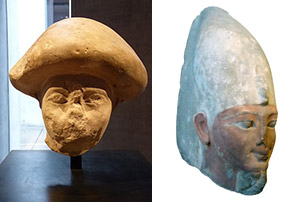
|
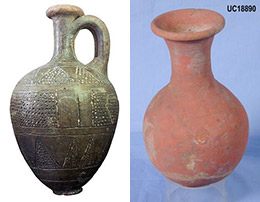
|
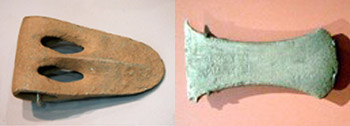
|

|
2. West Semites Abandon the Delta
Following the reconquest of the north by Ahmose, many West Semitic sites in the Delta seem to have been abandoned. For example, in the Hyksos capital of Avaris: [19]
- The royal palace and citadel of the late Hyksos period (Areas F and H) were completely abandoned, later to be replaced by a new palace/fortress of Egyptian design.
- The extensive West Semitic domestic quarters in Areas A/II and A/V were almost completely abandoned, and their tombs sacked.
A similar picture applies all along the Pelusiac branch of the eastern Nile delta:
- The Hyksos border fortress of Tjaru at Tell Ḥebouwe I was taken by Egyptian forces and rebuilt as an 18th dynasty fortification.[20]
- The West Semitic settlement at Tell el-Yahoudiya[21] was abandoned.
The West Semitic settlements in the Wadi Tumilat were also abandoned around this same time.[22]
- Tell el-Maskhuta remained unoccupied for centuries.
- At Tell er-Rataba (possibly Egyptian Per-Atum, biblical Pithom), the Second Intermediate Period settlement was abandoned and the site remained unoccupied until the mid-18th[23]
- Archaeological surveys suggest that a similar picture holds at Tell es-Sahaba, at Tell el-Kuꜥa, and at Tell el-Nazzazat, none of which have yet been excavated.
In those sites that do remain inhabited, most of the distinctive material culture of the Second Intermediate Period Delta, associated with its West Semitic population, disappeared. It was replaced by a material culture with its antecedents in southern Egypt, which the Theban conquerors had brought with them.[24]
Documentary sources for the fate of the Delta’s population are scanty. The tomb epitaph of Ahmose si Abina refers to a handful of enemies who were killed or taken captive (line 14), but says nothing about what happened to the majority of the population. There is a possible reference to refugees on the Speos Artemidos inscription of Hatshepshut (line 40), written three-quarters of a century later:
I have made distant those whom the gods abominate, and earth has carried off their foot(prints).[25]
Finally, there is the much later account of the 3rd century B.C.E. Egyptian historian Manetho, who claims some 240,000 refugees fled to Canaan (Josephus, Contra Apionem, I.14(89)).[26]
It would be difficult to explain all this without assuming a massive exodus of West Semitic refugees. Some of the West Semitic population did remain in place,[27] and the West Semitic presence in the Delta regrew under the subsequent New Kingdom.[28] Nevertheless, West Semites were never again organized as a distinct political or cultural community.
3. Natural Disasters
Egyptian sources report several natural disasters that afflicted Egypt just before the collapse of Hyksos rule, including abnormal weather conditions and an outbreak of disease. As in the Torah, they blame these disasters upon divine intervention by a deity of the West Semites.
Rhind Papyrus — A graffito on the reverse of the Rhind Mathematical Papyrus (Figure 5) laconically reports a storm that struck the Delta during one of the Theban campaigns, probably the final campaign during which Avaris ultimately fell. This graffito, like the mathematical text itself, was written in the Delta, and thus provides a unique window into how the population of the Delta viewed events. Besides noting the fall of Heliopolis at the southern end of the Delta and the fortress of Tjaru in its northeast corner, the graffito reports:
III Regnal year 11, first month of akhet, birthday of Seth: a sound of thunder was emitted by the Majesty of this god; birthday of Isis: the heavens rained.[29]

A major rainstorm in late summer (first month of akhet),[30] the middle of the dry season, would have been quite unusual. Besides falling in the middle of the Theban campaign, the thunderstorm happened to begin on the day (just before the Egyptian New Year) named after the deity Seth. Seth, in turn, was identified with the West Semitic storm god Baʿal Haddu.
The anonymous northern author thus described this storm as a divine theophany (a divine voice of revelation through the thunder) of the West Semitic storm god Baʿal Haddu in his Egyptianized guise as Seth. The author does not tell us what he thought Seth/Baʿal Haddu was saying, but the context suggests it had something to do with the collapse of Hyksos rule.
Tempest Stele — The Tempest Stele provides a much more detailed description of the same or another storm that struck Thebes sometime during the reign of the victorious 17th dynasty ruler Ahmose.[31] The account is particularly noteworthy for its reference to prolonged darkness:
The gods [caused] the sky to come in a tempest of r[ain], with darkness in the western region and the sky being unleashed without [cessation, louder than] the cries of the masses, more powerful than […], [while the rain raged (?)] on the mountains louder than the noise of the cataract which is at Elephantine. Every house, every quarter that they reached […] floating on the water like skiffs of papyrus opposite the royal residence for a period of […] days, while a torch could not be lit in the Two Lands. Then his Majesty said, “How much greater this is than the wrath of the great god, than the plans of the gods!” (lines 8–12)[32]
The stele continues with Ahmose restoring the temples that were damaged in the storms.
Certain details suggest that the Theban Egyptians, like their northern enemies, understood this storm as a theophany of the Egyptianized West Semitic deity Seth/Baʿal Haddu.[33] Furthermore, there is archaeological evidence that the Temple of Seth/Baʿal Haddu at the Hyksos capital of Avaris was among those which Ahmose rebuilt.[34]
Hearst Medical Papyrus — The Hearst Medical Papyrus, copied during the early 18th dynasty shortly after the Expulsion of the Hyksos, contains an incantation against a “(Disease) of the Ꜥꜣmw (West Semites)” involving black skin lesions.[35] It blames this disease upon pꜣ-nṯr-ḥry, an Egyptian rendering of the supreme West Semitic deity ˀEl ꜤElyon (God most High), mentioned in the Bible (ostensibly as a synonym for the God of Israel). The resort to an incantation suggests that this disease was often fatal, and beyond the empirical medicine of the time. The incantation appears to have been newly composed shortly before the papyrus was copied, perhaps in response to a recent outbreak.[36]
The Torah — Several of the biblical plagues resemble one or another of these natural disasters. The two reports of dramatic storms attest to disturbed weather conditions that could underlie the biblical plagues of hail (Exod 9:13–35) and darkness (Exod 10:21–23),[37] and the winds that swept the locusts into the sea (Exod. 10:19) and blew back the waters of the Reed Sea (Exod. 14;21). The biblical reports of God speaking to Moses parallel the Egyptian interpretation of these storms as a divine theophany.
Likewise, the plagues of pestilence (Exod 9:1–7) and boils (Exod 9:10–12) closely resemble the “Disease of the Ꜥꜣmw” mentioned on the Hearst Medical Papyrus. The resemblance would be particularly good if the references are to tularemia or cutaneous anthrax,[38] both of which spread readily from domestic livestock to humans. A connection to the biblical death of the firstborn is also possible, while other plagues might be explained as a logical consequence of the disturbed weather conditions and/or epidemic.[39]
4. The Fall of Avaris and End of the 15th Dynasty
The Hyksos capital of Avaris figures prominently in the biblical account under its later name of “Rameses.”[40] According to the biblical account, it was in the Land of Rameses that Jacob and his sons had settled (Gen 67:11), at Rameses that the Israelites toiled in the construction of store-cities (Exod 1:11), and from Rameses that they departed at the start of the exodus (Exod 12:37, Num. 33:3,5). Although the narratives of Moses’ birth (Exod 2:1-11) and of his appearances before Pharaoh (Exod 5-12) do not specify where those events occurred, the setting of these events at a royal capital (Exod 1:15-2:10; 5-12) on a branch of the Nile (Exod 1:22; 2:3-6; 7:14-8:12) with overland access to Sinai (Exod 2:15; 4:18-28) matches the geographic situation at Avaris/Ramesses.
The fall of Avaris is represented in the biblical account by the departure of the Israelites from Rameses at the start of the exodus (Exod 12:37, Num. 33:3,5), followed by the Hyksos Pharaoh and his entourage in their chariots (Exod 14:5-7). The Israelites were forced to flee the same night that the crown prince was killed (Exod 12:29–36). In fact, the Israelites were ordered to depart by Pharaoh himself, and had to do so very suddenly. They were armed (ḥamušim) for military combat, but otherwise did not have time to make adequate provisions. This is what one might expect if a sudden deterioration in the military situation required rapid evacuation of the capital. The death of the Hyksos crown prince in the 10th plague (Exod 12:29), and the drowning of the Hyksos “Pharaoh” and his entourage in the Reed Sea (Exod 14-15), represent the end of the 15th dynasty.
The biblical references to Avaris by its later name of “Rameses” are anachronistic, since the city was only given this name by Ramesses II of the 19th dynasty.[41] Such anachronisms are common in biblical texts, which did not always reach their final form until long after the events they purport to describe.[42]
5. Ancient Egyptian Tradition
The idea that the Israelite exodus and the defeat of the Hyksos were somehow related goes back to Manetho, an Egyptian priest writing in the 3rd century B.C.E. Pieces of his lost work survive in quotes by Josephus in his Contra Apionem (1:14.73–92, 1:26.227-250) and by other ancient writers.[43] Unfortunately, although Manetho clearly had access to some ancient Egyptian sources and traditions, his account was written more than a thousand years after the event. Furthermore, the quotes and paraphrases from his history are a jumble, and it is difficult to disentangle his work from later interpretation.
In his history, Manetho referred to the population of the Delta under Hyksos rule as the “Shepherds.” His general understanding seems to have been that the Jews were descended from these Shepherds, who ended up in Jerusalem after being expelled by the native Egyptians. He misinterpreted the title “Hyksos” as meaning “Shepherd-Kings” and included a detailed although garbled account of their expulsion. Josephus and other early Jewish and Christian writers thus cited Manetho as evidence for identifying the exodus with the Expulsion of the Hyksos.[44]
However, Manetho also introduced these Shepherds into his account a second time, in conjunction with the Osarseph legend and the “Expulsion of the Lepers.” At least some versions of Manetho identified Moses with the legendary Osarseph (Josephus, Contra Apionem I:26.250).[45] This legend itself combines elements from the Expulsion of the Hyksos, the Amarna age, and anti-Jewish propaganda into one.[46]
An unambiguous identification of the exodus with the Expulsion of the Hyksos reportedly appeared in the lost writings of the late 1st cent. B.C.E. Hellenistic Egyptian historian Ptolemy of Mendes. Tatian (Oratio ad Graecos. 38) quotes him as saying that “the departure of the Jews from Egypt to the places whither they went occurred in the time of King Ahmose, under the leadership of Moses.”[47]
Modern Egyptologists have also noted the overlap between the expulsion of the Hyksos and the exodus story.[48] However, attempts to identify the Israelites with the Hyksos trigger an immediate contradiction: The Hyksos were rulers not slaves.[49]
The Hyksos and Their Subjects
In order to make sense of the biblical account in terms of events at the end of the Second Intermediate Period, one must identify not the Israelites but the Pharaohs of the enslavement and exodus with the 15th dynasty Hyksos rulers of the Delta. The Hebrew slaves of the biblical account should be sought instead among their lower-class West Semitic subjects. The biblical enslavement traditions then have a natural explanation in terms of power and class relationships between the Hyksos rulers and these lower-class subjects.

The term Hyksos derives from the Egyptian term Ḥqꜣ-ḫꜣst, meaning “(a) ruler of (a) foreign land,” a term the Egyptians used to describe the petty kings of Canaan. The plural form, Ḥqꜣ-ḫꜣswt, “ruler of foreign lands,” implies an overlord of these petty kings, and was employed by some rulers of the Delta as a title (Figure 6). Although the term Hyksos is sometimes misused today as an ethnic appellative for the entire West Semitic population of the Delta during this period, contemporary Egyptian sources apply it only to these rulers.[50]
Despite their own foreign origin, the later 15th dynasty rulers tried hard to emulate the trappings of native Egyptian rulers and to represent themselves as the legitimate rulers of all Egypt. They abandoned the title “ruler of foreign lands” (Hyksos) and adopted Egyptian titles of kingship (such as “Son of Re” and “the Good God”[51]) instead.[52] They commissioned inscriptions in Egyptian hieroglyphic, employed Egyptian scribes to copy Egyptian texts,[53] issued scarab-beetle shaped seals and amulets bearing their names,[54] and dedicated gifts to Egyptian deities.[55] Although they never actually ruled over a united Egypt, they did control their own capital of Avaris, the former Old Kingdom capital of Memphis, and the former Middle Kingdom capital of Itj-Tawy.[56] At the peak of their power, their control extended at least as far south as Cusae (El Quseyya), halfway between the Delta and Thebes, and possibly beyond.[57]
Although the occupants of the Delta were largely West Semitic, most of them were not Hyksos—and they certainly were not members of the 15th dynasty. That is, they were neither rulers nor conquerors, and are never referred to as Hyksos in contemporary Egyptian sources. Instead, they were farmers and herdsmen, shepherds and cowherds, seamen and caravanners, weavers, dyers, and other artisans. They or their ancestors had settled peacefully in the Delta during the latter portion of the Middle Kingdom and early part of the Second Intermediate Period. Some of these early settlers appear to have been fairly wealthy; others served as artisans and skilled laborers on Egyptian estates.[58] Still others may have arrived as indentured servants, or chattel slaves.[59]
In the world of the ancient Near East, the king viewed his subjects as his servants, and his subjects viewed themselves as servants of the king. Biblical Hebrew even uses the same word—ebed—for “slave,” “servant,” “vassal,” “subject” (of a king), and “minister” (of a king).
From the perspective of northern Egyptian residents, the 15th dynasty king was their ruler, northern Egypt was Egypt, and their ruler was king of Egypt. The existence of another Egyptian kingdom, ruled by native Egyptians, 700 km to the south, would have been largely irrelevant. Thus, in Israel’s memory, they were subjects/slaves/vassals/servants to the King of Egypt, and the fact that this king was himself West Semitic and not native Egyptian was a fine distinction, lost in the mists of time.
Slaves to the Hyksos
The 15th dynasty rulers of the Delta would have required large numbers of workers to construct their capital cities and to build fortifications. At the peak of their power, they would have relied heavily upon forced laborers brought from Upper Egypt in the south as tribute or prisoners of war. However, as the Theban conquest of the north progressed, any such supply of labor from the south would have dried up. The Hyksos rulers would have been largely forced to depend upon the population of the Delta, including their own West Semitic subjects, for labor instead—especially for any last-ditch efforts to strengthen the defenses of the capital.
The Torah describes the enslavement of the Hebrews thus:
שמות א:יא וַיָּשִׂימוּ עָלָיו שָׂרֵי מִסִּים לְמַעַן עַנֹּתוֹ בְּסִבְלֹתָם וַיִּבֶן עָרֵי מִסְכְּנוֹת לְפַרְעֹה אֶת פִּתֹם וְאֶת רַעַמְסֵס.
Exod 1:11 So they set tax collectors over them to oppress them with forced labor; and they built supply cities for Pharaoh: Pithom and Rameses.[60]
Both mas (tax) and sevel (forced labor) are technical terms referring to taxation through corvée labor. This is a system of taxation in which each person was required to spend part of the year working on royal projects, or in which each city, tribe, or other unit was required to provide a certain percentage of its population to work on such projects. Taxation through corvée labor was common among West Semitic rulers; the Bible describes Solomon and his son Rehoboam doing the same (see 1 Kgs 4:6; 5:27–28; 9:15, 20–23; 12:1–19).
Egyptian sources also complained vociferously about the excessive taxes imposed by the Hyksos rulers and maltreatment of the people. On the First Kamose Stele <line 4> the Theban ruler Kamose complained that “no one can be at ease when they are milked by the taxes of the Ꜥꜣmw (West Semites of the Delta)”.[61] The Ramesside era story of “Apophis and Seqenenre” likewise recalled that “prince Apophis (a Hyksos ruler) … had put the entire land under taxes, the North as well yielding all the fine products of the Delta.”[62] Manetho reports (Contra Apionem, 1:14.75), “they treated all the inhabitants most hatefully, slaughtering some, and leading into slavery the children and wives of others.”[63]
The 15th dynasty rulers of the Delta are known to have engaged in some massive construction projects at their capital of Avaris (Biblical Rameses) and elsewhere, which would have required significant amounts of such manpower. Most noteworthy is the almost exclusive use of mudbrick as a building material, usually without even a stone foundation. The Hyksos palace in Area F/II at Tell el-Dabʿa (Avaris) is an obvious example.[64] To its north (Area H), a major landfill protected by a massive mud-brick retaining wall housed a royal garden as well as secondary administrative buildings.[65]
The story of “Apophis and Seqenenre” attributes construction of a famous temple of Seth/ Baʿal Haddu at Avaris to a 15th dynasty ruler named Apophis; that temple was rebuilt several times and remained in use for centuries. Manetho (Josephus, Contra Apionem, I.14(78,86)) and possibly the Second Kamose Stele (line 9) refer to massive defensive walls surrounding the capital, although little archaeological trace of these has been found. Some of the temples in Area A/II may also have been royal projects.[66]
The essence of the biblical complaint against “Pharaoh” was not that he had reduced the Israelites to the status of chattel slaves who could be bought and sold for money, but rather that he had abused his authority by overworking and overtaxing his subjects. A “servant” of the king could even be a high government official, such as the “servants of Pharaoh” mentioned repeatedly in the plague accounts (e.g., Exod 7:20 and elsewhere). The ready access which the Israelite elders (zekenim) and foremen (nogsim and shoterim) had to “Pharaoh” suggests that these servants, too, were actually high officials of the 15th dynasty, responsible for organization of the work force.
The Hyksos – Israelite Connection
In the biblical story, when the Israelites escape from Egypt, they wander through the Sinai wilderness and the Transjordan for forty years, and then cross over into the Cisjordan and settle there. On the face of it, this is a serious problem for any attempt to date an exodus to the Hyksos period, since the fall of the Hyksos dynasty (ca. 1535 B.C.E.) took place three hundred years before the settlement of the Israelites in the Cisjordanian highland (ca. 1200 B.C.E.). This is clear from the archaeological record and is not disputed by any serious scholar.[67]
It is nevertheless possible that the Israelites who settled in Canaan at the beginning of the Iron Age (ca. 1200 B.C.E.) may have included descendants of refugees who had fled Egypt at the end of the Second Intermediate Period (ca. 1535 B.C.E.). Nothing about these settlements suggest that they arose through a recent influx of population from Egypt; instead, they seem to have arisen through some combination of immigration from Transjordan, sedentarization of pastoral semi-nomads long present in the vicinity, and/or population overflow from Canaanite cities.[68]
Two groups mentioned in the historical records for the pre-settlement period may provide missing links:
- Shasu—Egyptian New Kingdom texts describe various groups of shasu (šꜣsw,), i.e., “nomads,” living in the Transjordan. One of these groups inhabited the “Shasu land of Yhwꜣ,” and has been identified by a number of scholars as proto-Israelite.[69] Manetho translated shasu as “Shepherds,” identified them with early Israelites, and placed these Shepherds in Egypt under Hyksos rule. This is apparent from his false etymology of the title “Hyksos” as meaning “Shepherd Kings” (‘Ὑκ+Σώς = ḥkȝ + shasu) (Josephus, Contra Apionem 1:14.82).[70]
- ʿApiru (or Habiru)—Many Egyptian and Akkadian documents from this period describe groups of ʿapiru living on the fringes of society. The El Amarna tablets, in particular, refer to ʿapiru living in Transjordan, the mountainous interior of Cisjordan, and the Galilee. The term is cognate with Hebrew (עברי), which is a term used to describe the Israelites in the exodus story.[71]
It is at least possible, therefore, that some of the West Semites of the Delta escaped to Canaan and Transjordan, where they became part of the local population of seminomadic groups. It was out of these semi-nomadic groups that Iron Age Israel later emerged.[72]
The Biblical vs. Egyptian Viewpoint
Although the biblical sojourn, plague, and exodus accounts parallel real historical events and conditions from the end of the Second Intermediate Period in Egypt, the biblical and Egyptian sources present very different perspectives on these events. This is not surprising, for the biblical account is written from the viewpoint of West Semitic refugees from the Delta and their descendants. By contrast, almost all the surviving Egyptian accounts of events at the end of the Second Intermediate Period stem from the victorious Theban Egyptian conquerors of the Delta or their successors.
The Theban Egyptian accounts had no interest in the wartime suffering of the population of the Delta and the fate of the refugees, and instead extols the military prowess of the victors. The biblical account, in contrast, seems entirely unaware that a competing Egyptian (17th) dynasty existed in the south, and that it was these rival kings who were responsible for the overthrow of the 15th dynasty “Pharaoh.”
Instead, the Bible attributes the downfall of “Pharaoh” to his own wickedness in abusing his own subjects and ignoring the divine will. It thus focuses on the contemporaneous natural disasters, which could be readily attributed to divine action. In this, one sees the roots of the ethical monotheism that was to become Israel’s primary contribution to the world.
TheTorah.com is a 501(c)(3) nonprofit organization.
We rely on the support of readers like you. Please support us.
Published
January 25, 2021
|
Last Updated
April 13, 2024
Previous in the Series
Next in the Series
Footnotes

Dr. Joseph Weinstein is an interdisciplinary researcher with widespread interests in science, technology, ancient history, and archaeology. He holds a Bachelor’s degree in Physics from Princeton University, a Master’s in Jewish Education from Boston Hebrew College, and a Ph.D. in Physics from MIT, and spent most of his professional career in private industry at Bolt, Beranek, and Newman (now Raytheon BBN Technologies) in Cambridge, MA. His activities in archaeology have focused on application of statistics and scientific data analysis techniques to pottery and other artifacts from the Ancient Near East. Participants in the annual SBL/AAR conference will recognize him as the person who usually organizes Shabbat meals and services.
Essays on Related Topics:





